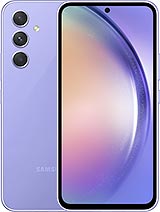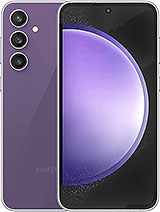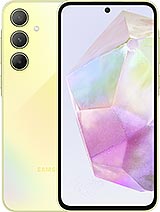Samsung Galaxy A55 review

Slightly larger 120Hz OLED
This year's Galaxy A55 basically borrows the A54's display and adds 0.2" on top. The A55 is now built around a 6.6-inch OLED screen with a 120Hz refresh rate and regular old 1080 x 2340 pixels resolution. The panel also supports HDR10+ and has the necessary Widevine L1 certification for high-quality, HDR-enabled streaming on Netflix and Amazon Prime Video.

Despite its modern features, the display doesn't have the modern looks for 2024. The 2024 trend is toward trimming bezels, and Samsung might have missed the memo. Some competitors, including even cheaper Redmi Note 13 phones, have visibly thinner bezels. Surely, it isn't a deal-breaker, and some people wouldn't mind the bezels, but it's something worth noting.
Back to the actual substance - the Galaxy A55's display performance hasn't changed coming from the A54. We got up to 1,010 nits of maximum brightness in auto mode, while manual control can only get you to 446 nits.
Anything above 1,000 nits is pretty solid for this price bracket and will provide good enough sunlight legibility. However, it would be unfair not to note that some cheaper phones beat Samsung at its own game and offer more than 1,400 nits of brightness.
Refresh rate
Refresh rate control is pretty standard. You have two options - Adaptive and Standard. The latter puts a cap at 60Hz, while Adaptive will try to keep the refresh rate at 120Hz in most scenarios. However, when showing static images or playing video, the display will dial down to 60Hz.
Battery life
Our new Active Use Score is an estimate of how long the battery will last if you use the device with a mix of all four test activities. You can adjust the calculation based on your usage pattern using the sliders below. You can read about our current battery life testing procedure here. For a comprehensive list of all tested devices so far, head this way.
The Galaxy A55 uses the same 5,000 mAh battery as its predecessors, but it's running a new Exynos 1480 chipset, which promises improved efficiency. However, we have to take into account the display, which is now 0.2" larger and could contribute to increased power consumption.
Yet, we see a significant improvement in battery life over the Galaxy A54. There are notable improvements in all tests except gaming.
The new Galaxy A55 achieves an Active Use Score of 13:27h, which is very good. Web browsing and call time see improvements, but our video streaming test is by far the biggest upgrade compared to last year's model.
Compared to its rivals, the Galaxy A55 clearly does well, beating each and everyone except for the Nothing Phone (2a). The Exynos 1480 seems to be spot on for power efficiency.
Charging speed
The charging speed has stayed the same as the Galaxy A55 still relies on the 25-watt Power Delivery protocol, which isn't very competitive in its price bracket. It takes about 1 hour and 3 minutes to complete a full charging cycle, while a 30-minute charge would only bring the battery to 55%.
As you can see from the chart below, plenty of other similarly priced phones outpace the Galaxy A55 by a good margin and come with the appropriate charger in the box, too.
You'd have to buy a 25W Samsung charger separately or a third-party 25W PD 3.0, PPS-capable brick to get the most out of the charging.
Speakers
Like its predecessors, the Galaxy A55 features a hybrid stereo speakers setup, meaning it has a main, downward-facing speaker and one that also acts as an earpiece. Naturally, there's a significant discrepancy in loudness between the two speakers, but Samsung managed to narrow the gap. The bottom-firing speaker is still louder, but not by much.
We don't know whether the A55 uses the same speakers as the A54, but they are tuned differently now and slightly louder. A score of -25.6 LUFS earns the Galaxy A55 a "Very Good" rating in terms of loudness.
Quality-wise, the speakers leave a bit more to be desired from the high-frequency sounds at maximum or near-maximum volume, but the bass is prominent and the vocals sound way cleaner than before. In fact, the A54 sounds muffled compared to the A55, so it will most likely be a great option for watching movies or listening to podcasts without headphones.
Use the Playback controls to listen to the phone sample recordings (best use headphones). We measure the average loudness of the speakers in LUFS. A lower absolute value means a louder sound. A look at the frequency response chart will tell you how far off the ideal "0db" flat line is the reproduction of the bass, treble, and mid frequencies. You can add more phones to compare how they differ. The scores and ratings are not comparable with our older loudspeaker test. Learn more about how we test here.
Reader comments
- Anonymous
- 21 hours ago
- X@G
This is a perfect midrange phone, and the cons is not daily breaker like : - No charger in the box and not very fast to charge (you can buy original 25 watt fast charger only for 10 USD) - Unreliable fingerprint reader performance (still acceptab...
- Nero
- 07 May 2024
- fnF
Wow huge price difference.. Here in KE its 500usd..





